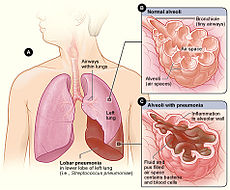Pneumonia
| Pneumonia | |
|---|---|
| Classification and external resources | |
 | |
| ICD-10 | J12., J13., J14., J15., J16., J17., J18., P23. |
| ICD-9 | 480-486, 770.0 |
| DiseasesDB | 10166 |
| MedlinePlus | 000145 |
| eMedicine | topic list |
| MeSH | D011014 |
Pneumonia is a disease of the lungs and the lower respiratory system. The lung contains many small bulbs, or sacs, called alveoli. These help to take out oxygen from the air. In the case of pneumonia, these bulbs become inflamed. The lungs fill up with a fluid which is called pus, and can no longer absorb as much oxygen as before. This is called empyema or emphysema (emp-ee-eema). This makes it hard for the person with pneumonia to breathe. They may feel out of breath, or like they are drowning. They may also feel pain when they breathe. Sometimes people die (30% of patients under 65) of pneumonia, even when they go to a hospital and take medicine (21% in-hospital mortality rate all patients ages).
Background
[change | change source]Pneumonia is an infectious disease that can be caused by bacteria, viruses, fungi or parasites. It may be spread outside of hospitals (community-acquired pneumonia) and can both cause or be caused by other related disease present, including CA-MRSA (community acquired flu) or be hospital acquired (called nosocomical) if it happens 48 hours or less after visiting hospital. It can also be caused by chemical or physical damage done to the lungs. Other illnesses, like alcohol abuse or lung cancer, can also result in pneumonia.
People with pneumonia usually have difficulty breathing. They may also cough, or have pain in the chest area. The treatment of pneumonia depends on how the illness was caused. If it was caused by bacteria or fungi, antibiotics can be used to treat it.
People of all ages can have pneumonia. The disease is dangerous. Many people die from pneumonia, especially old people, or people or babies with a weak immune system.
According to some research in 2010, in some parts of the world where people are very poor like India, Nigeria, Pakistan, and Guinea pneumonia was the cause of death for more children under the age of five than any other disease. Statistically, however, for every 2,000 children in the developing world who die of pneumonia, only one child in the developed world dies from the disease. This is because of differences in health care.
Treatment
[change | change source]Pneumonia can be treated with medications that target the specific source of the infection. This might be an antibiotic, an antiviral, or an antifungal medication taken by mouth as a tablet or intravenously. Other therapies support a patient by providing comfort. These may include oxygen given by nose or mouth, inhalers to breathe in and expand the lungs, or steroids to decrease swelling.
Other types of pneumonia
[change | change source]
- Severe acute respiratory syndrome (SARS)
- SARS is a highly contagious and deadly type of pneumonia which first occurred in 2002 after initial outbreaks in China. SARS is caused by the SARS coronavirus, a pathogen (disease-causing organism) that was not known until then. New cases of SARS have not been seen since June 2003.
- Bronchiolitis obliterans organizing pneumonia (BOOP)
- BOOP is caused by inflammation (swelling or irritation) of the small airways of the lungs. It is also known as cryptogenic organizing pneumonitis (COP).
- Eosinophilic pneumonia
- Eosinophilic pneumonia is invasion of the lung by eosinophils. Eosinophils are a particular kind of white blood cells. Eosinophilic pneumonia often occurs in response to infection with a parasite or after exposure to certain types of environmental factors.
- Chemical pneumonia
- Chemical pneumonia (usually called chemical pneumonitis) is caused by chemical toxins such as pesticides, which may enter the body by inhalation (breathing in) or by skin contact. When the toxic (poisonous or harmful) substance is an oil, the pneumonia may be called lipoid pneumonia.
- Aspiration pneumonia
- Aspiration pneumonia (or aspiration pneumonitis) is caused by accidentally inhaling oral (mouth) or gastric (stomach) contents into the lungs, either while eating, or after reflux or vomiting, and causing damage to the lungs. The lung inflammation from these materials is not an infection but it can eventually cause one, since the material taken into the lungs may contain bacteria. Aspiration is a common cause of death among hospital and nursing home patients, since they sometimes cannot cough hard enough to protect their airways.
